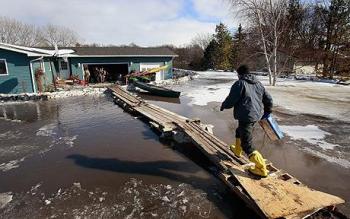 (Reuters) – National Guard troops were going door-to-door on Wednesday urging Minot, North Dakota, residents hit by river flooding to leave their homes as officials began to cut natural gas service to neighborhoods.
(Reuters) – National Guard troops were going door-to-door on Wednesday urging Minot, North Dakota, residents hit by river flooding to leave their homes as officials began to cut natural gas service to neighborhoods.
Volunteers, contractors and National Guard soldiers and airmen also are racing to extend and raise levees in North and South Dakota cities including the capitals to hold back the swollen Missouri River.
Up to 12,000 Minot residents could be displaced by rising waters along the Souris River, a Red River tributary, where flooding has eclipsed records set in damaging floods in 1976 and 1969. Mandatory evacuations started on Tuesday.
The flooding also has forced Amtrak to suspend service on its Empire Builder line west of St. Paul due to flooding that has closed BNSF tracks and damaged the Amtrak station in Minot, the rail service said Wednesday.
Heavy rains and a deep melting snowpack from a snowy winter have led to historic water levels in the Missouri River basin and nearby river systems ranging from Idaho to North Dakota and down through South Dakota.
Six reservoirs on the Upper Missouri River are straining at or near capacity, forcing the U.S. Army Corps of Engineers to release record flows that will push the river several feet above current already high levels.
The Missouri River basin forms the northwest bowl of the massive Mississippi River system that stretches from the rockies to western New York at the top and funnels water through Louisiana to the Gulf of Mexico.
The Corps held back on releasing the flows to take some of the edge off record Mississippi River flooding this year. The flows will take nearly two weeks to reach the Mississippi River by St. Louis. Mississippi flood stages are expected to be extended a few weeks by the Missouri flows, but not raised.
“It is a lot of water to move,” said Eric Stasch, operations manager for the Corps at the Oahe Dam above Pierre.
Above the North Dakota capital at Bismarck and nearby Mandan, the Corps was opening Garrison Dam spillways on the Missouri for the first time.
The Corps does not expect to open a spillway from the Oahe dam above Pierre, the South Dakota capital, but was shaping the area with bulldozers to stop water from flowing down a highway if the spillway must be opened.
Progress was seen across South Dakota in flood preparations and levees in Pierre and Fort Pierre were expected to reach at least base levels by late Thursday as planned, officials said.
Officials believe up to 2,000 Pierre residents may be displaced by flooding this year.
More than 800 of 1,100 residences in Dakota Dunes near the Iowa border may sustain flooding and residents should have possessions moved and property secured by late Thursday for possible evacuation, Governor Dennis Daugaard said.
Daugaard said he was still considering mandatory evacuations in Dakota Dunes and residents should expect to be out of those properties for up to two months. Two helicopters were laying sandbags in Dakota Dunes and a third may be added.
“We are making progress, but it is a tall order,” he said.
Dakota Dunes streets were designed to reduce speeds and protect residents, which has made it harder to move equipment and material to build levees, Daugaard said.
The Corps has started gradually releasing water from the reservoirs, but is expected to step up the pace quickly after the weekend to reach maximum flows by mid June, making roon for additional water flowing in from the rains and thaw.
Governors from Montana, the Dakotas and Wyoming have called up hundreds of National Guard soldiers to bag sand, assist in levee building and control traffic as contractors extend the length and height of levees along the rivers.
In Montana, some 200-plus people remained in a Red Cross shelter in Billings who fled flooding on the Little Bighorn and Bighorn rivers on the Crow Indian Reservation in the southeast part of the state.
Residents of Roundup in central Montana have been encircled by the Musselshell River, forcing food and water to be carted in by emergency personnel.
The Red Cross said its Montana-wide shelter operation has been its biggest ever in that state, registering 1,844 shelter stays and serving more than 8,800 meals. State officials expect the flood fight to continue for weeks with the bulk of a record mountain snowpack yet to melt.


